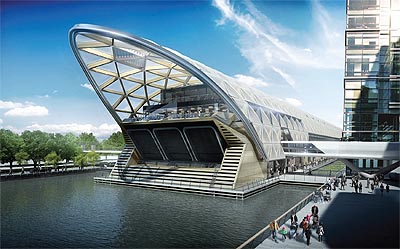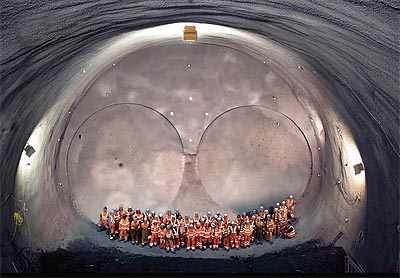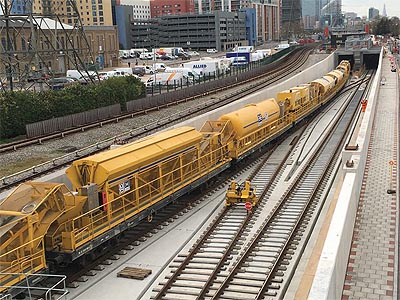Crossrail
Representing one of the most significant infrastructure projects ever undertaken within the UK, Crossrail is a major investment that will enhance the lives of commuters travelling across London. Construction & Civil Engineering speaks to the project’s Technical Director, Chris Sexton, about the current progress of construction and on-going developments
A city lifeline
Representing one of the most significant infrastructure projects ever undertaken within the UK, Crossrail is a major investment that will enhance the lives of commuters travelling across London. Construction & Civil Engineering speaks to the project’s Technical Director, Chris Sexton, about the current progress of construction and on-going developments
With London representing one of the world’s most dynamic and rapidly growing cities, the demands placed on its transport systems are set to increase in line with the economic trends across the  capital. Indeed, the House of Commons, Regional and Local Growth Statistics (Daniel Harari, December 2016) report reveals that London regional growth for 2015 reached a gross added value (GVA) of £378 billion – accounting for 22.9 per cent of total UK GVA for the period. The south-eastern region accounted for a further 15.1 per cent (£249 billion) of the UK’s GVA for the year, meaning that London and the South East of England together provided 38 per cent of total UK GVA (£627 billion) for 2015.
capital. Indeed, the House of Commons, Regional and Local Growth Statistics (Daniel Harari, December 2016) report reveals that London regional growth for 2015 reached a gross added value (GVA) of £378 billion – accounting for 22.9 per cent of total UK GVA for the period. The south-eastern region accounted for a further 15.1 per cent (£249 billion) of the UK’s GVA for the year, meaning that London and the South East of England together provided 38 per cent of total UK GVA (£627 billion) for 2015.
As the London economy continues to grow, so too does the capital’s population and average number of trips that are made across the city each day. Figures published within the Transport for London (TfL) document Travel in London Report 8 (TfL, 2015) show that the average number of trips made by both London residents and non-residents has continued to increase year-onyear, reaching some 26.6 million trips per day in 2014. This number includes all journeys with an origin, destination or both within Greater London and all modes of transport, such as cycling, walking, private transport and public transport. These numbers are projected to rise over the coming years, with the TfL Travel in London: At a Glance (TfL, 2016) report showing that the London population is expected to grow from 8.5 million in 2014 to circa 10.4 million in 2041. This forecast anticipates a rise in journeys across Greater London to 32 million trips per day, with an increase in peak demand of between 70-100 per cent.
These reports make it clear that London will face significant challenges in ensuring that it is able to provide the necessary infrastructure to drive the continued economic growth of the capital in the future. Crossrail represents a major undertaking in the pursuit of this end and presently constitutes the largest construction project in Europe, as well as one of the most significant single infrastructure investments ever made within the UK. The Crossrail project will introduce the Elizabeth line to the wider London rail network and transform travel across the capital, boosting the economy by billions of pounds and supporting thousands of new jobs and homes.
“The new railway system for London and the South East will run for 118 kilometres (73 miles) from east to west and account for over 200 million passenger journeys per year. Once completed, it will provide 24 trains per hour in each direction in the central section during peak times. This represents an increase in central London’s rail network capacity of around ten per cent and will bring a further 1.5 million people to within 45 minutes of Central London,” reveals Technical Director, Chris Sexton. “In planning for Crossrail a business case was submitted to ensure that the project represented value for money and this business case is owned by the project’s sponsors, comprising TfL and the Department for Transport. The main aim of Crossrail is to increase the capacity of  the London rail network, however the new line will also reduce travelling times across the city. For example, a journey from Heathrow to Canary Wharf that can be expected to take over an hour in practical terms, will be reduced down to around 40 minutes.”
the London rail network, however the new line will also reduce travelling times across the city. For example, a journey from Heathrow to Canary Wharf that can be expected to take over an hour in practical terms, will be reduced down to around 40 minutes.”
While its construction began in 2009, the concept of a new east-west metro service was first considered as early as the 1940s. This idea became a more tangible reality during the late 1980s following the publication of the Central London Rail Study (1989), with the concept further evolving into the Crossrail Hybrid Bill, which was introduced to Parliament in 2005. The Bill subsequently gained Royal Assent in 2008, with construction work officially beginning during the following year. Despite being a mammoth undertaking that has been closely followed by media sources from around the world, work on the Crossrail project has progressed with impressive determination and technical expertise during the subsequent years. The new Elizabeth line is on course to go into service as advertised according to the development timetable, while remaining within the budget allocated to the project by TfL and the Department for Transport. “Crossrail is progressing both on time and on budget. In terms of budget we tend to talk about being within our £14.8 billion funding envelope.”
The new Elizabeth line route will comprise of two main sections, the first of which is made up of the central section and ten new stations, many of which co-exist with existing London Underground stations. Running from west to east, these new stations are Paddington, Bond Street, Tottenham Court Road, Farringdon, Liverpool Street, White Chapel, Canary Wharf, Custom House, Woolwich and Abbey Wood station. The second component of the Elizabeth line will be integrated with the existing rail network in a western section running from Paddington to Heathrow and Reading, as well as current rail infrastructure on an eastern section between Stratford and Shenfield in Essex. These will join the central section to complete the Elizabeth line in its entirety and a number of upgrades have been undertaken by Network Rail in preparation for the arrival of the new line.
The Elizabeth line services will be operated through central London by a fleet of new Bombardier Class 345 Aventra trains from December 2018 with four other stages to complete the new route in December 2019.
As of March 2017, infrastructure works across the Crossrail project are more than 80 per cent complete. The programme’s ambitious tunnelling operations were successfully concluded during May 2015, following the efforts of dedicated teams of workers that laboured 24 hours a day to complete the tunnels as part of Europe’s largest civil engineering project. Over the coming months Crossrail’s contractors have been hard at work to complete associated civil works, while moving to hasten the introduction of mechanical, electrical, and plumbing (MEP) works. “Since completing tunnelling operations we have been finishing off in terms of civil works with some of the cross passages and adits that have been added underground throughout the Elizabeth line, but principally  focus has shifted to MEP works and to the installation of rail systems, as well as to completing station features themselves,” Chris details. “All of the platform structures along the central section of the line are now complete and ready for the installation of new platform edge screens. The Elizabeth line will feature platform edge screens (PES) and platform screen doors (PSD) on all of its central section stations, with Knorr-Bremse tasked with manufacturing the platform doors. The infrastructure for the PSDs is complete and there is a programme to fit the delivered screen doors during the coming months.”
focus has shifted to MEP works and to the installation of rail systems, as well as to completing station features themselves,” Chris details. “All of the platform structures along the central section of the line are now complete and ready for the installation of new platform edge screens. The Elizabeth line will feature platform edge screens (PES) and platform screen doors (PSD) on all of its central section stations, with Knorr-Bremse tasked with manufacturing the platform doors. The infrastructure for the PSDs is complete and there is a programme to fit the delivered screen doors during the coming months.”
Presently around 80 per cent of the track relating to the Crossrail project has been successfully laid, with contractors working from each end of the central section. This has involved the use of a concreting train travelling from the line’s largest railhead at Plumstead in south-east London, while a concreting shuttle service is in operation at the western end in Westbourne Park. While workers have been busy laying the required track for the Elizabeth line, contractors have at the same time been focused on installing vital systems across the network. “Concurrently with track laying operations, contractors have also gained access to the network’s tunnels to allow the installation of communications, signalling, high voltage and traction power and ventilation systems,” Chris explains. “Contractors have also had access to rooms within the stations, into which they are fitting the end-to-end railway systems, particularly the supervisory control and data acquisition (SCADA) communications and power units within stations. There is a programme of handing over rooms from the stations to the railway systems team and we are around half way though implementing this, while in terms of MEP works the platforms are now recognisable as underground stations and the cable management systems are in the process of being installed.”
The delivery of the Crossrail project has been typified by ambition, engineering challenges and technical innovation. This has been demonstrated by the use of a spray concrete lining within the completed underground tunnels and the further use of glass fibre reinforced concrete (GFRC) panels within each of the stations – representing a relatively new technique for projects of this scope. “The structure onto which the GFRC panels will be fitted is in place and the panels themselves are now beginning to go into the tunnels. Across the stations of the Central Elizabeth line, the superstructure onto which the PSDs will be fitted are in place and the framework for the GFRC is also fully completed. Escalators are beginning to arrive into the stations and all of the cable management and ventilation systems are in the process of being installed. As you might expect with any project of this size, we have had a steady flow of engineering challenges of various sorts but we have been able to solve every obstacle that we have encountered. Every single day throws up new engineering problems but we have an excellent engineering team that is up to the challenge of devising innovative solutions,” Chris says.
“The design collaboration between Crossrail and its supply chain, as well as the designers working for the project’s main contractors has ultimately resulted in a fully co-ordinated design that we can build and finally sign off as a completed project,” he continues. “Across all Crossrail operations we further give the highest priority to safety, which we remain fully committed to addressing through our ‘Target Zero’ campaign that is focused on driving safety to the point that there are no accidents on the Crossrail project. We have a RIDDOR accident frequency rate (AFR) of 0.11, which is considered to be a very good benchmark for industry performance, but we continued to operate according to the belief that everyone has the right to go home every day safely and that all harm is preventable.”
As the first stage of the implementation of Crossrail rapidly approaches, project planners and contractors are engaged in a flurry of activity to prepare the network in accordance with the project’s deadlines. As rolling stock begins to arrive and stations start to take their final form, Crossrail is increasingly close to becoming a stunning operational success. “The new Class 345 Aventra trains are currently being delivered. It is actually possible to see the trains undergoing testing on the Great Eastern line. The next really big milestone for Crossrail is the start of dynamic testing, which is due to start in November 2017. This will involve testing the rolling stock on the network infrastructure,” Chris concludes. “Dynamic testing was originally due to commence in April 2018, but we brought this forward to November 2017 because we are in a position to do so and because it will allow for a longer period of dynamic testing, which will be of greater benefit to the programme as a whole. In order to be ready for dynamic testing in November there are several areas in terms of building infrastructure that must be ready, for example the track must be energised and we have to have the communications backbone working end-to-end in the area where dynamic testing is being implemented. There are a lot of critical activities that are going on before November 2017 and we have a ‘Master Operational Handover Schedule’ (MOHS), which sets out the milestones for the deliverables to be ready for dynamic testing and beyond.”
Crossrail
Services: Crossrail represents a major London infrastructure project